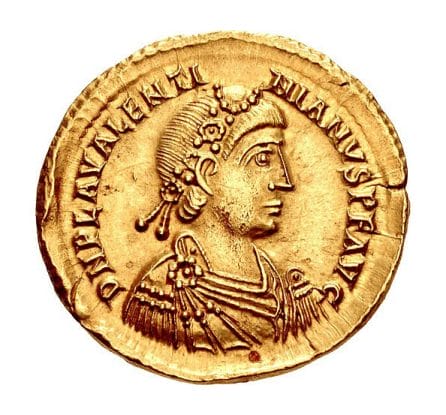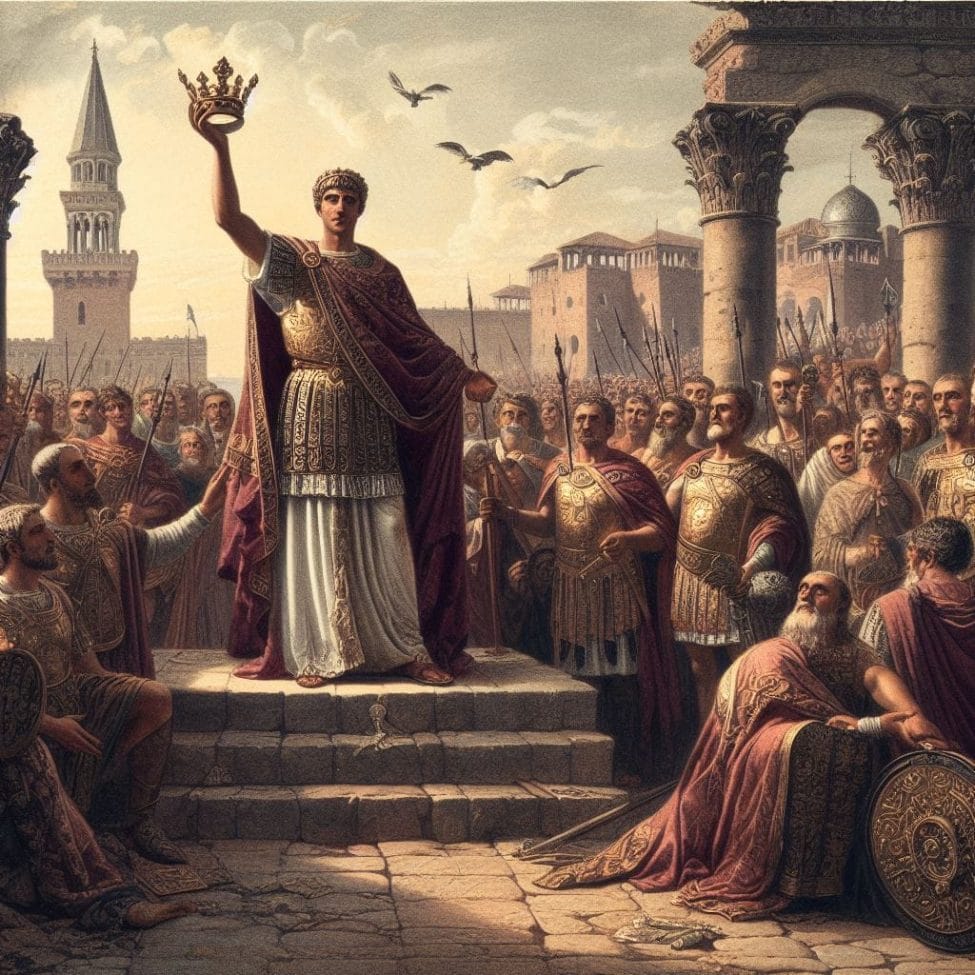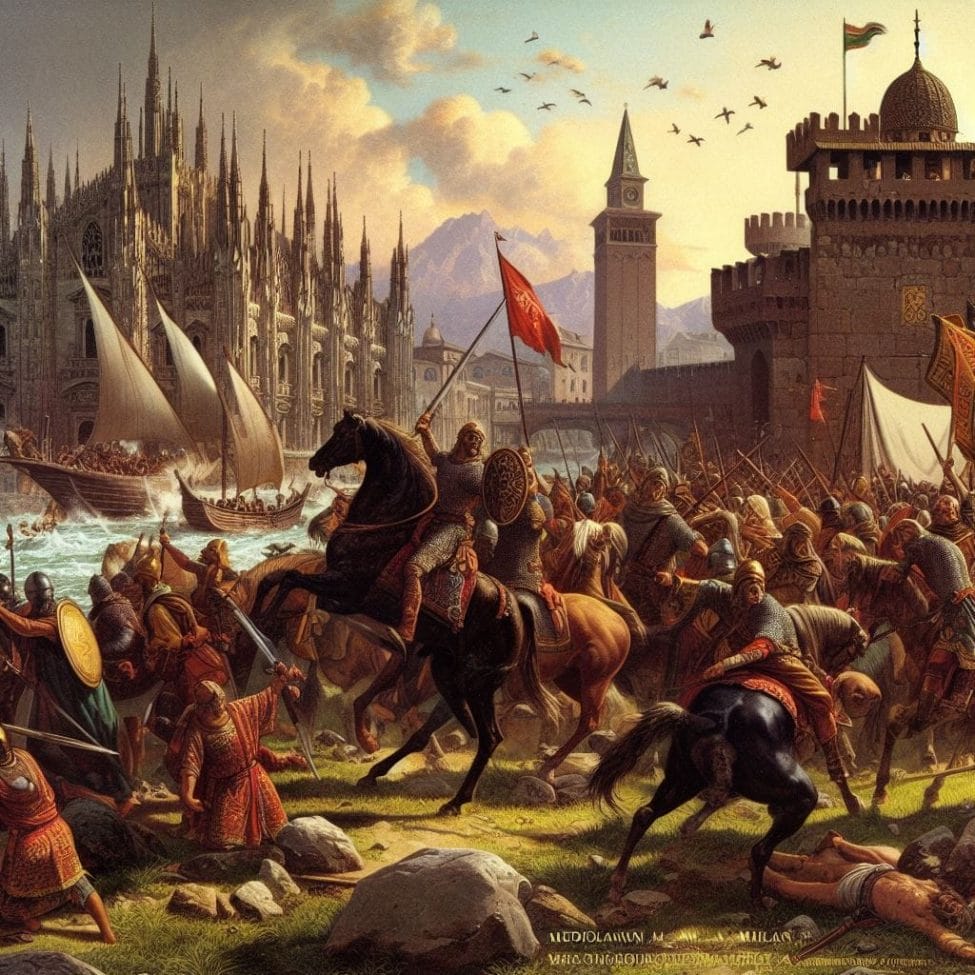Last Updated on October 31, 2023 by Vladimir Vulic
Life: AD 419 – 455

- Name: Flavius Placidus Valentinianus
- Born AD 419.
- Became emperor in AD 425.
- Wife: Licinia Eudoxia (one daughter; Placidia).
- Died 16 March AD 455.
Valentinian III was born in AD 419, the son of Constantius III and Aelia Galla Placidia, who was the half-sister of Honorius. With Honorius having no children of his own, he proclaimed Valentinian III his heir (AD 421 or shortly after).
In AD 423, when Placidia fled from the court of Honorius due to his advances toward her, she took the young Valentinian III and her daughter with her. They took refuge at the court of Theodosius II in Constantinople.
Honorius died later in AD 423, and with the heir apparent absent, his throne was usurped by John, a civil servant who was maneuvered into position by Castinus, the powerful ‘Master of Soldiers’ of the west, who was an enemy of Placidia. Theodosius II, opposed to the usurper, now belatedly recognized Constantius III (who had died in AD 421) as Augustus in order to champion the cause of Valentinian III.
Becoming a Caesar
The young Valentinian III, in preparation for his taking the Western throne, was elevated to the rank of Caesar in Thessalonica in AD 424. A military expedition was then organized by the eastern emperor to conquer the western capital, Ravenna, and depose John. Placidia and her children sailed on the very fleet which set out to Italy.

The two generals, Ardaburius and Aspar, succeeded in conquering Ravenna, and John was captured, sentenced to death by Placidia in Aquileia, and executed in May or June AD 425. Valentinian III was hailed Augustus in Rome in AD 425 at the age of six. Placidia became the regent of the Western empire.
The Impact of Placidia and Aetius
Valentinian III, like other emperors of that period (for example, Honorius and Theodosius II), was a ruler who left the governing of his empire to others. At first, during his childhood, he should have his mother, Placidia, take care of the government, and later, rule lay much in the hands of his military chief, Aetius. While others governed, Valentinian III chose far more to have a good time. He enjoyed physical activity and was said to have been a good runner and a skilled horseman and archer. Further, he liked the company of astrologers and magicians.
And though his wife, Licinia Eudoxia, whom he married in AD 437, was famed for her ravishingly good looks, he is said to have repeatedly had affairs with married women. The first crisis in Valentinian III’s reign was soon to come when General Aetius arrived with his relief force of Huns only to find that emperor John, whom he sought to save, had already been executed.
Naturally, the arrival of a man at the head of such a large army was a threat to the new government. And so Placidia made a deal with Aetius to regain control of this dangerous situation. And so Flavius Aetius was made ‘Master of Horse’ and sent to Gaul, whilst his army of Huns was paid a large bribe to simply return home.
In Gaul, Aetius achieved remarkable successes against the Franks and Visigoths during AD 427-8. This should only make Placidia more suspicious of him. For she evidently feared he sought to usurp the throne. In spite of this, Aetius’ successes forced her to promote him to ‘Master of Soldiers’ in AD 429.
In the same year, AD 429, the Vandal leader Geiseric crossed from Spain to North Africa with his people. There, he declared himself an independent king, free from Rome or any allegiance to Valentinian III, and set out to conquer Rome’s African domains. In AD 431, Geiseric’s Vandals, moving east, heavily defeated the Romans in North Africa.
Events in Europe
Meanwhile, back in Europe, Placidia hoped for her main army supporter, Bonifatius (Boniface), to rid her of Aetius. Bonifatius had returned from Africa to Italy in AD 429, and ever since, war between him and Aetius had been brewing. The two finally clashed in AD 432. Bonifatius was defeated, wounded, and later died.
Aetius went on to drive the Germans back behind the Upper Danube, put down revolts in Gaul, and in AD 437, he smashed the Burgundians as they sought to invade Gaul. Considering the military difficulties of the time and the shortage of soldiers in the Roman army, these victories were outstanding achievements.
Events in North Africa
Yet the deterioration in North Africa continued. In AD 439, Geiseric conquered Carthage, and in AD 441, once again, heavily defeated a Roman force sent against him. With the Western empire suffering from an ever more desperate shortage of military manpower, things only got worse. Then, in AD 450, the eastern emperor Marcian canceled the annual subsidy to the Huns. Was this inevitably to encourage Hun aggression, then Justa Grata Honoria, the sister of Valentinian III, played a vital part in the way things should unfold.
Valentinian III sought to arrange a marriage for her, a marriage to an elderly dignitary of which Honoria disapproved. Hence, she now took the drastic step of sending her signet ring to Attila, king of the Huns, urging him to come to her rescue. Attila interpreted this as an offer of marriage and demanded no less than half the Western Empire as his dowry. Naturally, this was rejected, which caused Attila to lead his terrifying Huns into Gaul.
Attila’s Rome Campaign
In AD 451, on the Catalaunian Plains (Châlons), Aetius, together with the Visigoths, met Attila’s Huns, who were reinforced by many German tribes. The battle saw the death of the Visigoth king Theodoric I, but Attila was decisively beaten. However, instead of withdrawing back into Germany, Attila, in AD 452, moved into Italy, with Aetius unable to stop him.

The Huns captured and sacked Mediolanum (Milan), destroyed Aquileia, and then marched on Rome. Aetius, without the Visigoths, could not possibly take on an army the size of Attila’s and was forced to stand by as this happened. But as Rome lay helpless to the menacing Huns, pope Leo I somehow persuaded Attila to turn back and leave the ancient city unscathed. Attila withdrew and, in AD 453, died. His empire fell apart almost at once, the Hun menace to the empire disappearing as fast as it had arisen.
Final Days of Valentinian’s Rule
In AD 453, Aetius’ son was betrothed to Valentinian III’s daughter Placidia. Aetius thereafter was granted his fourth consulship in AD 454. He stood at the height of his power, having effectively ruled the Western empire at the head of the military for two decades. However, at court, he had influential and deadly enemies, foremost among them the former praetorian and city prefect Petronius Maximus and the emperor’s chamberlain Heraclius.
Having been threatened by Aetius, they conspired with Valentinian III, who himself felt very intimidated by Aetius to murder him. In September AD 454, while Aetius was delivering a financial account, Valentinian III and Heraclius attacked him in the throne room and stabbed him to death. But with the powerful Aetius no longer in control, the court was gripped by intrigues.
With the death of Aetius, the powerful Petronius Maximus now hoped to take his place, but Heraclius prevented that, managing to persuade Valentinian III that this would be a dangerous appointment. Angry, Maximus sought revenge. And so he found two Scythians (or Huns), called Optila and Thraustila, whose loyalty still demanded vengeance for the murder of their master Aetius.
On 16 March AD 455, Optila and Thraustila were among the guards of the imperial entourage as the emperor practiced archery on the Campus Martius at Rome. Everyone was taken by surprise as Thraustila stepped forward and murdered Heraclius, and Optila struck the head of Valentinian III, causing wounds from which he died.
People Also Ask:
Who assassinated Valentinian III?
Valentinian’s reign saw the slow dissolution of the western empire, including the loss of Africa to the Vandals and Atilla’s invasion of Gaul. Valentinian III was assassinated in 455 as the result of a plot instigated by the senator Petronius Maximus.
Which Roman emperor got so mad he died?
Valentinian became so angry that a blood vessel in his brain exploded, killing him instantly. He would be known as the last great Western Emperor to rule an empire at peace.
What is Valentinian III known for?
Valentinian III, Latin in full Flavius Placidius Valentinianus (born July 2, 419, Ravenna [Italy]—died March 16, 455, Rome), Roman emperor from 425 to 455. At no time in his long reign were the affairs of state personally managed by Valentinian.
Who is thought to be the greatest Roman emperor?
Unsurprisingly, the title of the “first greatest Roman emperor” goes to Caesar Augustus. While in his youth, Octavian plunged Rome into one of the bloodiest civil wars and toppled the Roman Republic; as emperor Augustus, he created the strong foundation for one of the truly greatest of all empires in human history. He is often regarded as one of the greatest Roman emperors due to his significant contributions to the empire’s stability, expansion, and cultural development.

Historian Franco Cavazzi dedicated hundreds of hours of his life to creating this website, roman-empire.net as a trove of educational material on this fascinating period of history. His work has been cited in a number of textbooks on the Roman Empire and mentioned on numerous publications such as the New York Times, PBS, The Guardian, and many more.
